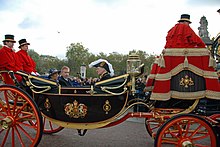Marshal of the Diplomatic Corps

His Majesty's Marshal of the Diplomatic Corps is a senior member of the Royal Household of the Sovereign of the United Kingdom. He is the King's link with the diplomatic community in London, arranges the annual diplomatic corps reception by the Sovereign, organises the regular presentation of credentials ceremonies for ambassadors and high commissioners, as well as supervises attendance of diplomats at state events. Marshals generally hold office for ten-year terms and were formerly retired senior military officers, though the last three marshals have been diplomats. The marshal is assisted by the Vice-Marshal of the Diplomatic Corps, the First Assistant Marshal, in addition to other assistant marshals.[1]
The office was created as recently as 1920 to replace the former Master of the Ceremonies, an office dating from c.1620. Before 1920, the Vice-Marshal was known as the Marshal of the Ceremonies.[2] The Marshal of the Diplomatic Corps wears a distinctive two-sided 17th-century badge of office, hung from gold chains (which was previously worn by the Master of Ceremonies):[3] in times of peace the picture seen is an olive branch, together with the motto Beati Pacifici (the personal motto of James I); in times of war the medal is reversed, to show the image of a brandished sword and the motto Dieu et mon droit.[4]
The Marshal of the Diplomatic Corps is, along with the King's Equerry, expected to walk backwards discreetly when leaving the presence of the monarch. They are the only two visitors who are expected to do this today, as the ancient tradition that all who had the honour of a meeting with the monarch were expected to walk discreetly backwards when leaving the Sovereign's presence has been dropped for health and safety reasons. These two senior members of the Royal Household are expected to walk backwards leaving the room when they have either been summoned to see the King personally or they are introducing others – such as senior foreign diplomats – for audiences with the King.[5]
List of Marshals of the Diplomatic Corps
[edit]- 1920–1934: Major-General Sir John Hanbury-Williams
- 1934–1945: Lieutenant-General Sir Sidney Clive
- 1945–1950: Sir John Monck
- 1950–1961: Major-General Sir Guy Salisbury-Jones
- 1962–1971: Rear-Admiral David Cairns, 5th Earl Cairns
- 1972–1981: Major-General Lord Michael Fitzalan-Howard
- 1982–1991: Lieutenant-General Sir John Richards, Royal Marines
- 1992–2001: Vice-Admiral Sir James Weatherall
- 2001–2008: Sir Anthony Figgis
- 2008–2014: Charles Gray
- 2014–present: Alistair Harrison
List of Vice-Marshals of the Diplomatic Corps
[edit]- 1936–1945: Sir John Monck
- 1946–1957: Sir Marcus Cheke
- 1957–1965: Captain Dugald Malcolm
- 1965–1972: Sir Lees Mayall
- 1972–1975: Sir John Curle
- 1975–1982: Sir Roger Du Boulay
- 1982–1986: Sir Eustace Gibbs
- 1986–1991: Sir Roger Hervey
- 1991–1996: Sir Anthony Figgis
- 1996–1999: Philip Astley
- 1999–2001: Kathryn Colvin
- 2001–2006: Charles de Chassiron
- 2006–2009: Sarah Gillett
- 2009–2012: Simon Martin
- 2012–2014: Anna Clunes
- 2015: Catherine Nettleton
- 2015–2017: Julian Evans[6]
- 2017–2020: Neil Holland[7]
- 2020–present: Victoria Busby
References
[edit]- ^ "The Lord Chamberlain's Office". gov.uk. Archived from the original on 23 December 2012.
- ^ Obituary of Sir Hubert Montgomery, The Times, 5 December 1942
- ^ Chamberlayne, John (1710). Magnae Britanniae Notitia: Or, The Present State Of Great-Britain (Volume 2). London: Timothy Goodwin et al. p. 115.
- ^ Risk, James; Pownall, Henry; Stanley, David; Tamplin, John (2001). Royal Service (Volume II). Lingfield, Surrey: Third Millennium. pp. 101–102.
- ^ Andrew Alderson (9 August 2009). "Royal tradition takes a backward step as the Queen bows to 'health and safety' concerns". The Telegraph.
- ^ "Julian Evans".
- ^ https://www.gov/uk/government/people/neil-holland [dead link]
